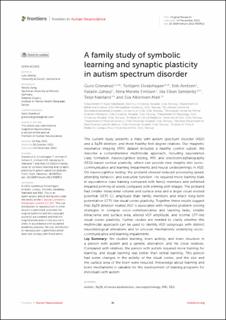| dc.description.abstract | The current study presents a male with autism spectrum disorder (ASD) and a 3q29 deletion, and three healthy first-degree relatives. Our magnetic resonance imaging (MRI) dataset included a healthy control subset. We describe a comprehensive multimodal approach, including equivalence class formation, neurocognitive testing, MRI, and electroencephalography (EEG)-based cortical plasticity, which can provide new insights into sociocommunicative and learning impairments and neural underpinnings in ASD. On neurocognitive testing, the proband showed reduced processing speed, attending behavior, and executive function. He required more training trials in equivalence class training compared with family members and exhibited impaired priming of words compared with priming with images. The proband had smaller intracranial volume and surface area and a larger visual evoked potential (VEP) C1 amplitude than family members and intact long-term potentiation (LTP)-like visual cortex plasticity. Together, these results suggest that 3q29 deletion-related ASD is associated with impaired problem-solving strategies in complex socio-communicative and learning tasks, smaller intracranial and surface area, altered VEP amplitude, and normal LTP-like visual cortex plasticity. Further studies are needed to clarify whether this multimodal approach can be used to identify ASD subgroups with distinct neurobiological alterations and to uncover mechanisms underlying sociocommunicative and learning impairments. Lay Summary: We studied learning, brain activity, and brain structure in a person with autism and a genetic aberration, and his close relatives. Compared with relatives, the person with autism required more training for learning, and visual learning was better than verbal learning. This person had some changes in the activity of the visual cortex, and the size and the surface area of the brain were reduced. Knowledge about learning and brain mechanisms is valuable for the development of training programs for individuals with autism. | en_US |

